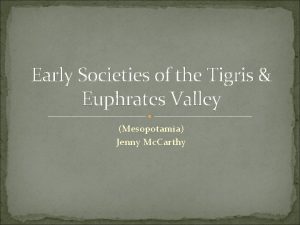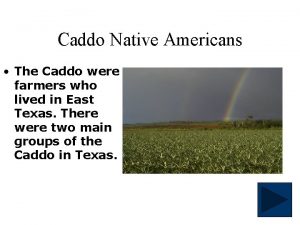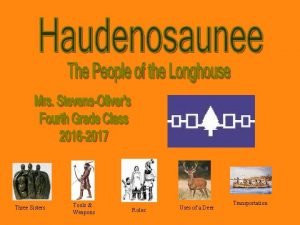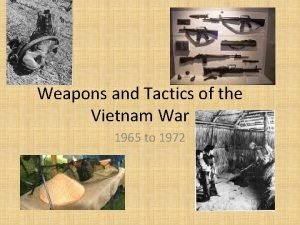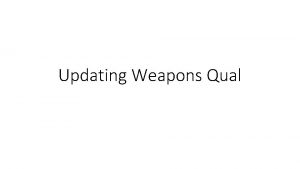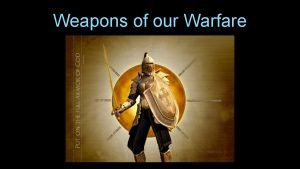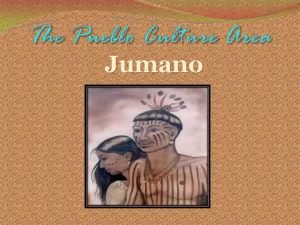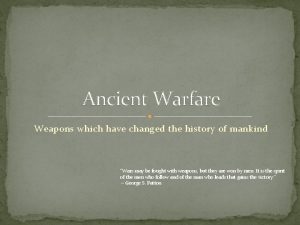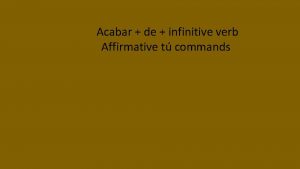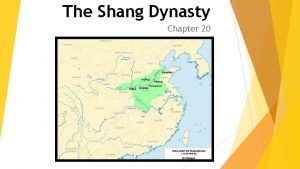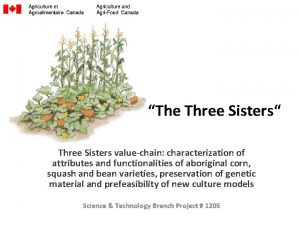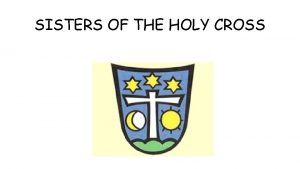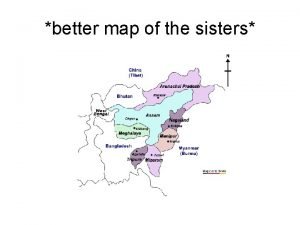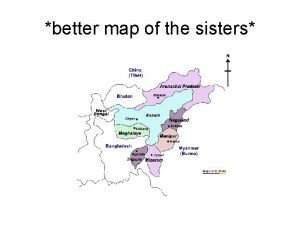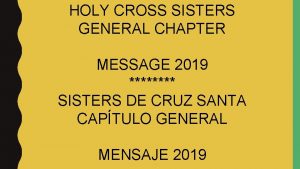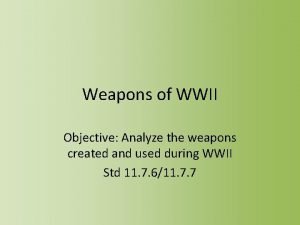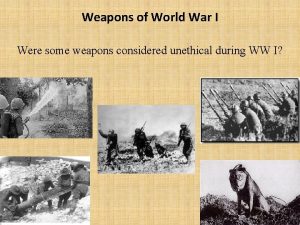Three Sisters Tools Weapons Roles Uses of a
















- Slides: 16

Three Sisters Tools & Weapons Roles Uses of a Deer Transportation

IMPORTANCE OF DEER By Andrew, Paul, Taisia, and Mara

These are the shoes (called moccasins) they wore them in the summer. They were made with deer hide. This is a Iroquois shirt. It was made from the hide of the deer. This is a scrapper made from deer antler. It was used to remove hair from the hide. This arm band rattle is made from deer toes.

The Importance of Deer were a very important part of the Iroquois life and culture. The clothing was made from deer hide, or deer skin. It was sewed with a needle made with small deer bones and thread made from deer sinew (made of deer tendons). Deer brains were made into cakes which were used for tanning the hide into leather used for clothing, moccasins, and summer doors on longhouses as well. Tanned clothing was smoked over a fire to make it water proof. The antlers were used for carving, tools, and weapons. They used the hide for the head of their water drums. Rattles were made from the hooves. Hoes were made from the bone, or scapula. The hide was used for carpets on the floor of the longhouses they were made by skinning the hide from the deer and washing it in the stream of boiling water. They used deer leather (made by tanning the hide into leather) for snowshoe netting and the netting of lacrosse sticks, lacrosse balls, and blankets. The skin was also used for trading to other tribes for something else. The Iroquois ate some of the deer meat fresh, and smoked some to have later. Every part of the deer was used by the Iroquois.

Iroquois Transportation By Zuri Akwaa, James Dougherty, Alex Doaga and Maddy Wabnitz

This is a picture of a dugout canoe. The Iroquois use these canoe to hunt And fish. This is a picture of a pair of Snowshoes. They are used for staying on top of the snow in the winter. This is a picture of a sled. Kids and audts use these sleds or also known as taboggens to play or hunt with.

Iroquois Transportation Iroquois Transportation The Iroquois have many different kinds of transportation. They can travel on the water by using dugout canoes that are made from wood and trees. They used elm wood, birch bark and a waterproof seal made from syrup, gum and charcoal to make the canoes. Some of the boats were called “the fishing boats”. The Iroquois used these boats to fish. Also, another way the Iroquois traveled was on land. The Iroquois traveled on their feet sometimes to hunt or walk to the village, messengers can run on the path, he can run fifty or more miles a day. Iroquois trails were only wide enough room for one person to walk or run. So many people use it to walk on it, it was beaten down a foot. Now the Iroquois trails are our highways in New York State. Another way Iroquois travel was in snow. The Iroquois used elm wood to build sleds and toboggans. They also used wooden snow shoes to travel and stay up in snow. The Iroquois had many ways to travel.

Jobs and Roles of Men, Women and Children Gregory Kuzin, Kyasia Hampton, Benjamin Walworth, Aliye Kocaoglu

Iroquois women had long hair. They wore deer skin clothes. Women also sewed porcupine quills into clothes. They also sewed beads onto their clothing for decoration. Children wore deer skin clothes. They had porcupine quills and beads in their clothes for decoration. Men did all the hunting in the family. They built the longhouses.

Jobs and Roles of Iroquois Men, Woman and Children By Aliye Kocaoglu, Gregory Kuzin, Benjamin Walworth, and Kyasia Hampton The men and women had a very important jobs. Men made tools for hunting. They also made weapons for war. The hunting tools were very important because they couldn’t get any meat without them. Men used bows to hunt. Young men had a very important job. They had to clear the land were a new longhouse would be built. After they cleared the area they build a new longhouse in the cleared area. Men had a very hard job. They had to clear farmlands. Men also had spiritual training. Women had jobs in the longhouse and in the fields. They planted crops and gathered chestnuts. They also cooked food and made clothes. They taught girls how to make pots. Women did all the work in the fields and kept the house in order. Women gathered all he food and they also sowed. They cooked food. They also tanned hides and made baskets. Children had jobs too. While boys learned to hunt, girls learned and did domestic jobs which means running the house or family relationships. Both boys and girls did spiritual training. Boys and girls learned from the men and women.

The Three Sisters By Ethan Westervelt, Peter Biglan, Roddy Brace and Shannon Moynihan

This is corn. It held up the beans. The corn could have been made into corn husk dolls. There are many types of corn. These are beans. They are in the legume family. Legumes take nitrogen from the air and convert it into a form that plants can use. This is squash. The leaves on the squash shade the ground to prevent weeds.

The Three Sisters By Ethan Westervelt, Peter Biglan, Roddy Brace and Shannon Moynihan The three sisters were very important to the Iroquois. The three sisters helped each other grow. The three sisters were important plants called squash, beans and corn. The corn held up the beans vines. Beans are helpful because they are in the legume family. Legumes take nitrogen from the air and convert it into a form that plants can use. The leaves on the squash shade the ground to help control the weeds so other plants could grow easy. All three sisters are used in many ways. One way you can use them is by making corn husk dolls. A few other ways you could use three sisters is by eating different kinds of corn such as succotash, grandfather corn, green fried corn, hulled corn or maybe even corn pudding! If you lived in a longhouse you would find bunches of braided corn hung up to dry from long house rafters. According to the text in the book, The Three Sisters by Marcia Eames-Sheavly it says, ’’Corn beans and squash were special gifts from great spirits. ’’ A fun fact about the three sisters is that autumn is a good time to look for corn. The three sisters are still important to the Iroquois today.

Tools and weapons of the Iroquois BY JIAWEI SUN, CAMPBELL KAZACOS, MAXWELL FOLTZ, AND JONAH KHISHCHENKO

Weapons Bows Weapons and Tools of the Iroquois Bows and arrows were used most in Iroquois history. Iroquois used a bow and arrow for hunting. They would hunt deer, rabbit, buffalo, moose, squirrel, turtles, bear, birds such as eagles for their wings to make their bows and arrows. Makuks are baskets that woman strap around their waists. Woman would carry them around and use them to collect berries. War Clubs Arrows have three different parts. One part is the shaft. The shaft is the longest part. The shaft is made out of wood. It’s important to pick the right wood for the shaft. The wood has to be sturdy so the arrow would not wobble. But flexible enough so the arrow would be shot straightly. Tools If your wondering what a club is it is a weapon with a heavy round head or a single spike. The clubs can also be called war clubs. Iroquois Containers The Iroquois made contains are made of bark, and they sewed sides of the containers together. They sewed one other piece on they bottom, so food would not fall out. They were able to store food in them.

Weapons and Tools of the Iroquois Weapons Some weapons of the Iroquois that were made of stone were knives, chisels, axes, scrapers, spear points, arrow heads and clubs. If you’re wondering what a club is it is a weapon with a heavy round head or a single sharp spike. An axe can be also be called a tomahawk. Axes can be used in hand to hand combat, thrown short distances, or used as a farming tool to cut wood. Axes can fit in both categories. It can be a tool, or a weapon. Knifes were a part of Iroquois history too. Knifes could be made of sharped stone, chert, obsidian, and particularly flint. Swords were not traditional weapons in Iroquois times. In Mexico a sword called Macuahuitl was used by Aztec Warriors. Arrowheads are another weapon. Whenever you hunt a different animal you need a different arrowhead. Arrowheads are made of pointed bones and antlers. Bows and arrows were used most in Iroquois history. Bow and arrow makers work very hard. They are skilled, smart, and creative. Bows and arrows were made of sinew (animal tendons) and wood. Sinew made the bow springer. In the text it says, in the Rocky Mountain area tribes used composite, animal bones, and layers of sinew. These were very powerful American Indian bows. Those kinds of bows can shoot completely though a buffalo! Most native American bows are made of sinew, yucca, turtle necks, and other plant fibers. Tribes rubbed their bows with bear grease. Bows can be seasoned with different oils. Weapons are very important to the native Americans. Tools Containers are made of steamed bark. Bark can creased and bent along the creases. The ends would meet and women would sew them together. After they would sew on a piece of bark that went on the bottom to make a container. Makuks are baskets made from birch bark. They were strapped to the waists of women so they could collect berries. The Iroquois made baskets of cornhusk too. Birch buckets were made to collect sap for maple sugar. Feathers can be turned into fans by stitching a piece of birch bark around the quills. Other fans were made by putting a strip of birch bark through a split twig
 Mesopotamia weapons
Mesopotamia weapons Algonquin tools and weapons
Algonquin tools and weapons Caddo tools and weapons
Caddo tools and weapons Three sisters bows
Three sisters bows Us weapons vietnam war
Us weapons vietnam war Iwq option
Iwq option What goes in a leaders book army
What goes in a leaders book army Ephesians weapons of warfare
Ephesians weapons of warfare Weapons of righteousness
Weapons of righteousness The weapons we fight with
The weapons we fight with Weapons of wwi
Weapons of wwi Weapons
Weapons Jumano jewelry
Jumano jewelry Ancient warfare weapons
Ancient warfare weapons Ven di sal haz ten weapons
Ven di sal haz ten weapons Weapons
Weapons Shang dynasty words
Shang dynasty words
